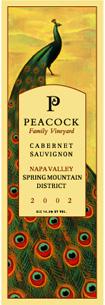 One of our specialties at Crush is finding rare, high-quality New World Cabernet Sauvignon for under $100. These are wines that have the palate impact of bottlings that sell for 50-200% more.
One of our specialties at Crush is finding rare, high-quality New World Cabernet Sauvignon for under $100. These are wines that have the palate impact of bottlings that sell for 50-200% more.
Small production wonders from this difficult-to-navigate category have been delighting our customers for the last year and a half.
Of note lately is the 2002 Peacock Family Vineyard Cabernet Sauvignon.
When someone comes in asking for one of the usual suspects on the auction circuit we hand them the wine that they're looking for and, if they're open to it, recommend a bottle of Peacock.
We say, "Let me know what you think about this one."
The next day they're either on the phone or back in "the Cube" grabbing a few more bottles.
The glowing reviews keep rolling in: not a single Crush customer has given anything less than "two thumbs up" to this little-known winery on Spring Mountain. While the vineyard has more famous neighbors including Pride, Paloma, and Philip Togni, to name a few, you're soon going to hear a lot more about Peacock.
Given the phenomenal response from our customers and an excellent showing at a recent staff tasting we had to let you know about the wine before the critics get their hands on it.
The wine is a tour-de-force of concentrated layers of full, round, dark fruit and spice with delicate tannins and finesse. This bottle is undeniably the product of superb mountain fruit that basked in near-perfect growing conditions of the sexy '02 vintage, a year that makes the hearts of California collectors skip a beat. 2002 is very much along the lines of 1994 and 1997 which drank great young and continue to improve (and go up in price!).
The Source

Peacock Family Vineyard, Spring Mountain
Peacock Cabernet comes from just over 6 acres of primo vineyards in the Spring Mountain District of Napa Valley (see Sidebar). At an elevation of 1,000 feet, Peacock's tiny mountain vineyard literally rises up to meet the sun with a terraced vineyard that faces South/Southeast. The fruit soaks up the sun all day long, while the cool mountain air acts like a refrigerator at night, preserving the fruit's intensity, balance, and finesse.
Rich and luxurious with a wide window of drinkability, this wine flaunts a complexity that's hard to come by at most price-points. Bring this wine to your friends who collect big-name Cali Cabs and see what they say. Show up at a dinner party and watch jaws drop. Or just grab some bottles and crack them open for yourself.
Bob Schagrin
Managing Partner
Crush Wine & Spirits
Know Your Napa!
Napa Valley is the iconic wine region of the U.S. Like Burgundy, Bordeaux, and Champagne, the name alone is enough to drive wine lovers into head-spinning frenzies. Unlike its French counterparts however, where land acquisition is nearly impossible (unless your last name is Rothschild or, better yet, Bonaparte) and the various districts have long since been set in stone, in Napa, things are still being sorted out.
While the simple moniker "Napa Valley" is assumed to mean the wine is a good one, today's knowledgeable connoisseur looks to the smaller districts within Napa Valley for wines of extraordinary distinction with quality winemaking. Here's a quick guide to the most prominent Napa Valley AVAs:
click map for larger versionSpring Mountain: North of Mt. Veeder, refers to section of Mayacamas Range. Warmer than Mt. Veeder, famed for the darkest hued, densest and most lusciously tannic Cabernets.
Stags Leap: Famed valley-floor district synonymous with powerful Cabernets. The "iron fist in a velvet glove." Two wineries also use the AVA name.
Oakville/Rutherford: The heart-of-hearts in Napa (with the most expensive land as well). Meaty rich wines with black current, olives, herbs, and mint. What one thinks of when one thinks of Napa Cabernets.
Diamond Mountain: North of, and warmer than, Spring Mt. Of all the Mt. districts, Diamond Mt. produces softest Cabernets, with the telltale note of dark chocolate.
Howell Mountain: On east side of valley, quite north. The AVA begins at 1,400 feet up. Cabernets are distinctly austere, minerally, and finessed, not unlike Bordeaux with a certain spiciness.
Mount Veeder: A 2,677-foot volcanic peak, with, you guessed it, volcanic soil. In the southwest part of the valley. Cabernets have unique earthy intensity, rich with good acidity and minerality. Poor vineyards can suffer from unripe, "green" flavors.
Carneros: Southern end of both Sonoma and Napa. Moderated by cool Pacific air that plows in through San Francisco Bay. Cooler microclimate makes it perfect for Chardonnay and Pinot Noir, which have made AVA famous.
Matt Kramer�s fine fine book, New California Wine, consulted in writing AVA summaries.

